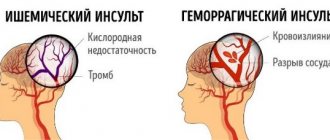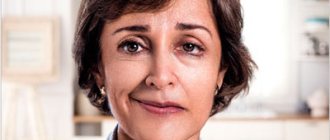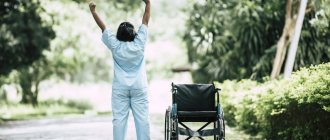After a stroke, neurological and visual disturbances often occur. In developed countries, 25% of cases of visual impairment are caused by stroke. In this case, vision loss can be complete or partial. Is it possible to restore vision after a stroke with the help of medical therapy, exercises and the right environment.
Why is a stroke dangerous?
A stroke is a sudden disruption of blood circulation in the brain, caused by a blockage of a vessel. If the vessels supplying blood to the optic lobes have been affected, vision loss may occur. Treatment of a stroke that damages the vessels of the occipital lobe of the brain, where the visual centers are located, is carried out in the same way as the treatment of other strokes. Therapy is jointly prescribed by a therapist, neurologist and ophthalmologist.
The degree of visual impairment after a stroke depends on the severity of the damage to brain tissue. When a small area is damaged, a small piece usually falls out of sight and a blind spot appears. Double vision, oscillopsia (the illusion of rotation of the environment), and loss of conjugate eye movements may also be present.
Up to 20% of stroke patients experience visual field impairment, but it is difficult to diagnose due to decreased level of consciousness and problems with communication. Loss of visual fields in mobile patients can cause injury.
Prevention
Like many other diseases, ocular stroke can be prevented by following simple preventive measures. First of all, it is worthwhile to promptly treat various diseases of the cardiovascular system and respiratory organs. This is explained by the fact that it is pathologies of the heart, arteries and veins that often cause ruptures or spasms of blood vessels. Under no circumstances should you self-medicate. Medications should be selected by a doctor.
In addition, it is recommended to maintain a balanced diet and proper drinking regimen. Saturating the body with beneficial vitamins and minerals will ensure the health of blood vessels and all internal organs. To do this, you should give up a large amount of animal fats, limit the consumption of salt, sugar, fatty, smoked, and sour foods. It is better to give preference to plant products, vegetables, fruits, preferably raw or baked.
Another important aspect is giving up bad habits and sufficient physical activity. These and other activities will help maintain not only the health of your eyes, but also your entire body for many years.
Damage to the optic lobes of the brain
A stroke is characterized by certain symptoms, and a simple analysis of the clinical picture allows doctors to identify areas of the brain damaged by ischemia and hemorrhage. If there is a sudden onset of headache, nausea, weakness and blurred vision on one side, you should immediately contact a medical facility. A stroke provokes a sharp deterioration of the condition. This can happen in hours or even minutes, so help must be provided as quickly as possible.
Symptoms of a stroke:
- sudden headache, dizziness, nausea and vomiting;
- disorientation in space;
- disorder of consciousness (short-term or long-term);
- sometimes coma, loss of vision;
- muscle weakness on one side, paresis or paralysis.
An accurate diagnosis, identification of the affected lobes of the brain and analysis of the extent of the process can only be made after an examination. However, the doctor must be able to recognize a stroke and symptoms of damage to a particular part of the brain, as this helps to navigate and provide first aid correctly. Loss of vision, headache, unsteady gait and numbness of the limbs on one side are sure signs of a stroke that has affected the visual centers of the brain.
It is believed that brain strokes are more common in men over 45 and 60 years of age. The condition can cause irreparable harm to the body, but experts say that a third of patients after a stroke have the opportunity to restore vision and other impaired functions.
Extensive cerebral embolism in the vast majority of cases causes damage to the visual centers and permanent impairment, while mild ischemia rarely causes long-term harm. Therefore, with minor damage to the brain, the functioning of the visual departments can be restored.
Most often, presbyopia (age-related farsightedness) develops with a stroke. It becomes difficult for the patient to work with small parts at close range. If in healthy people age-related farsightedness is almost inevitable and does not require urgent treatment, presbyopia after a brain stroke can result in irreversible loss of vision. There are also loss of certain areas of the visual field.
Central retinal vein occlusion
Venous outflow from the vessels of the retina is carried out by one single vessel - the central retinal vein . If this vein becomes obstructed, various problems may occur, proportional to the degree of obstruction. In the case of such a pathology, the patient notices:
* vision impairment,
* blurred image,
* appearance of floaters
* loss of visual fields.
These changes occur unexpectedly and progress over a period of time (from several hours to several days). As a rule, these changes occur in one eye, rarely in both eyes.
The basis of this pathology is, as a rule, vascular changes, blood clots (as well as with blockage of the arteries).
The most effective treatment for this disease is treatment of concomitant diseases (diabetes, hypertension, atherosclerosis) in the hope that blood flow will be restored.
In about a third of all cases, vision is almost completely restored, in a third it remains at the same level, and in a third there is further deterioration and significant loss of vision.
In the most severe situations, it is necessary to resort to laser treatment to prevent dangerous forms of glaucoma . however, laser treatment will not restore vision.
Restoring vision after a stroke - basic principles
In order to be able to restore vision in the future, if you have a stroke, you need to urgently consult a doctor and get qualified help. An ophthalmologist treats visual impairment after a stroke. All stages of recovery must be approved by a doctor. It is very important to analyze the results and adjust the rehabilitation scheme in a timely manner.
Principles of vision restoration after stroke
- moisturizing the eyes with drops and gels;
- restoration of affected visual functions with the help of medications;
- regular and correct exercise;
- diet with vitamins, especially vitamin A;
- taking nutritional supplements.
After a stroke that causes vision loss, you need to seriously engage in general rehabilitation and restoration of visual function. Without making an effort, the patient risks remaining blind for life, because medications are not able to restore vision completely. Rehabilitation may include exercises, medications, and even surgery.
Ways to improve vision after a stroke
- Gymnastics. Special exercises help stop the progression of presbyopia at the initial stage of its development. Before starting therapy, the visual organs should be prepared; it is recommended to hold your face over warm water and splash it into your eyes. There are a large number of techniques, so the choice is up to the ophthalmologist.
- Medicines. Medications for visual impairment after a stroke are prescribed when gymnastics is not effective enough. There are a large number of remedies, so the choice should also be entrusted to a doctor. It will take into account the characteristics of the disorders, concomitant pathologies and contraindications.
- Surgery. The operation is prescribed as a last resort. Patients usually require lens replacement after a stroke. In its place, a special lens is implanted, which performs all the functions of a natural lens and is combined with the structures of the eye. Surgery to remove the lens is one hundred percent prevention of cataracts.
It must be remembered that the problem of vision after a stroke is very individual. A recovery program is developed for each individual patient, taking into account the degree of damage and consequences. However, absolutely everyone is recommended to moisturize the mucous membrane with the help of drops and gels.
The influence of exercise therapy on the patient’s nervous system
Therapeutic exercise is the performance of certain physical exercises, which begin with the simplest movements of the patient after he regains consciousness, then the physical activity gradually increases, the exercises become more complex. Exercise therapy helps improve blood circulation in organs and tissues, accelerates the process of restoration of various body functions, and improves metabolism. Physical therapy exercises for each patient are selected individually depending on the severity of the patient’s condition and concomitant diseases. An individual physical therapy program at the Yusupov Hospital is drawn up by a rehabilitation doctor.
Make an appointment
Methods for improving vision after a stroke
After a stroke, artificial tears, Korneregel, Taufon, Normax, Taurine are prescribed. Hydration is extremely important for patients who have been in a coma.
During the rehabilitation period, you need to reconsider your diet. After a stroke, it is recommended to eat more carrots, yellow peppers, pumpkin, egg yolks and fish. Cataract prevention is provided by grapes, blueberries and onions.
After a stroke, it is useful to massage with hot or cold compresses. This helps relax the eyes and improve blood circulation. It is enough to wet one towel in cold water and the other in warm water, and alternate them for 5-10 minutes.
The usual tossing of a ball or ball helps in restoring vision. You need to throw the object back and forth from the affected side. Focusing your gaze on an object will help to establish synchronicity between movements and vision.
Computer programs will help to rehabilitate vision after a stroke. One of these programs shows a black square; at certain intervals, a cluster of one hundred dots flashes on the side of the affected eye. Exercises on the computer take 15-20 minutes a day. The course of treatment is several months.
Comparative exercises allow you to check the extent of visual focus impairment. They make it possible to determine the required degree of rehabilitation therapy. The patient should close his eyes and direct his gaze to the injured side of the body. After determining the correct (according to the patient) direction, the eyes are opened, and the doctor determines the proximity of the gaze from the desired direction.
Compensatory vision therapy stimulates the areas of the brain that support vision. It includes scanning, visual field recognition and prism exercises. The visual field can be adapted by moving images from invisible zones.
Prisms in ophthalmology are used to correct various visual impairments. The type and placement of the prism will be determined by the symptoms. In case of double vision, the prism is placed on a glass lens, which allows you to align the direction of view. Spatial neglect requires the use of a prism on the left side of the visual field so that it reflects objects on different sides.
Restorative vision therapy aims to stimulate nerve connections in the brain. There are different techniques for all types of visual impairments.
Usually, surgical treatment of the organs of vision does not help anything after a stroke, because the problem lies in the brain. Only in some cases does surgery correct double vision by affecting the eye muscles.
Medications
To normalize blood flow in the brain after a stroke and restore dead neurons, several groups of drugs are used.
Nootropics
The tablets help improve metabolism. During the treatment, the patient's oxygen delivery to nerve cells is normalized. The most effective drugs include:
- Nootropil 800 mg (270 r).
- Encephabol 100 mg (700 RUR).
At these prices, medications can be purchased in pharmacies in St. Petersburg.
Antiplatelet agents
This is another group of drugs that affects the fluidity and viscosity of the blood. Medicines prevent the development of thrombosis and normalize blood microcirculation in damaged tissues. To restore vision, doctors recommend using the following antiplatelet agents:
- Pentoxifylline 100 mg (80 r).
- Trental 100 mg (520 r).
Adenosinergic drugs
The therapeutic effect is to reduce blood viscosity and simulate the respiratory center.
Taking drugs from this group allows you to saturate the body with oxygen and increase the speed of blood flow. The following drugs help restore vision:
- Eufillin 150 mg (10 r).
- Pentoxifylline 100 mg (80 r).
Visual gymnastics after a stroke
To restore vision, it is recommended to perform a set of special exercises. Gymnastics helps maintain tone, strengthen muscles and brain function. All types of gymnastics are based on relaxing the eyes, reducing intraocular pressure, combating irritation and visual tension. Exercises can include any eye movements, focusing the gaze at different distances, drawing objects and images in the air. Long-term therapy makes the picture clearer and eliminates distortions.
If you experience partial vision loss after a stroke, exercise can help retrain your brain. Doctors include exercises in physical therapy. The simplest exercise is with a pencil. You need to hold the pencil at a distance of 45 cm and follow it with your eyes, moving the pencil up, down and to the sides. You can't move your head. Also, a pencil is placed in front of the patient’s face and moved to the sides.
After a stroke, it is recommended to work with puzzles and drawings. Patients can complete drawings of objects and shapes, play word games, and solve puzzles. Exercises like this help retrain the brain and help it identify objects using vision.
Even the simplest exercises help strengthen the muscles of the eyeballs, train muscle memory and track objects. Often after a stroke, muscle tone disappears. You can simply hold the upper eyelid with your fingers and try to close your eyes. Such exercises can prevent eye fatigue and relieve stress, but long-term structural damage in the brain is not corrected by exercise.
Exercises can only be beneficial if they are performed systematically. It is necessary to repeat the full course daily. Improvement can only be achieved in cases where there is minor vision loss. In case of serious disorders, therapeutic exercises should be combined with medication. Only comprehensive restoration will help restore vision.
Exercises to restore vision after a stroke
- Cover your eyes with your palms, inhale and exhale deeply several times. Gently press with your palms on the upper and lower edges of the eye socket. Start with 3-4 repetitions, increasing the number of approaches.
- Gently press your fingers into the indentations above the eyeballs. Make vibrating movements, sharply release your fingers. Repeat 5 times.
- Gently press on the eyes, sharply releasing your fingers. Repeat 5 times.
- Close your eyes tightly and relax your eyes.
- Squeeze the bridge of the nose near the corners of the eyes. Hold for 5 seconds, then quickly release your fingers. Repeat 5 times.
If the patient cannot perform gymnastics on his own, relatives or hospital staff can help him. Eye exercises are not effective in restoring damaged brain cells, but exercises help relieve eye strain and eliminate redness and burning.
It is recommended to combine exercises with drug therapy and training of other parts of the body that have been damaged (limbs, face, jaws). Only an integrated approach will allow complete rehabilitation after a stroke.
There are no diseases that go away without consequences for the body. Stroke is one of those conditions that extremely negatively affects a person’s quality of life, depriving him of basic functions: vision, speech, movement. A stroke causes an acute circulatory disorder, including in the brain, an organ that is responsible for the functionality of the body. Vision problems occur if the lesion is localized in the area of the vessels that supply blood to the visual center in the brain.
Visual impairment can be a complication of a stroke or an independent disease (ocular stroke). Poor blood circulation in the brain very often affects the visual centers. After a stroke, vision also deteriorates due to infections acquired in intensive care.
Sources used:
- Kvasova M. D. Vision and heredity. - Moscow / St. Petersburg: Dilya, 2002.
- Textbook of eye diseases. Volume I: monograph. / E. Fuchs. - M.: State Publishing House of Medical Literature, 1988.
- D. Hubel. Eye, brain, vision. — ed. A. L. Byzova. - M.: Mir, 1990.
- International Council of Ophthalmology
Recommendations
Stroke is an extremely serious disease that leads to damage not only to the visual organs, but also to other organs. Therefore, immediate contact with specialists at the first signs of a stroke is of paramount importance. It is also important to note that an independent disease such as an eye stroke often occurs. In this case, a separate course of treatment is prescribed. The recovery period will directly depend on how quickly medical care was provided and, of course, on the degree of damage and the age of the patient. Today, strabismus after a stroke can be cured in various ways or using an integrated approach. What kind of therapy will be determined solely by the ophthalmologist.
Species and types
The classification is as follows:
- Monocular. When the healthy eye is closed, the patient continues to see a double image;
- Binocular. Double vision occurs when the patient looks at an object with both eyes at the same time.
This disease is also divided according to the type of plane in which the split image occurs:
- Vertical - distortion occurs vertically due to refraction created by the oblique eye muscles.
- Horizontal – image distortion occurs horizontally. The cause is a disruption of the normal functioning of the rectus ocular muscles.
- Cross - the projection of the image occurs crosswise: the image from the right eye appears on the left and vice versa. This causes great discomfort for the patient.
Types of diplopia:
- Temporary. Occurs after a traumatic brain injury, overwork, during severe headaches, as a side effect of taking certain medications, due to severe poisoning and after alcohol intoxication.
- Congenital.
- Strabogenic. Occurs along with strabismus.
- Paralytic. The cause is paralysis of the extraocular muscles.
Symptoms and signs of double vision
The patient complains of double vision: complete, partial, at a certain point in the visual field.
This symptom also depends on the distance from which a person looks at the object. There are cases when double vision occurs when looking at close or distant objects.
There is a difference in the contrast and brightness of parts of one object in question.
A frequent accompaniment of diplopia is dizziness.
It is difficult for the patient to move in space, drive a car and simply move various objects. This occurs due to a slight loss of orientation.
In addition to all of the above, when the image is doubled, painful sensations occur in the eyes.
Useful video
Treatment for double vision:










